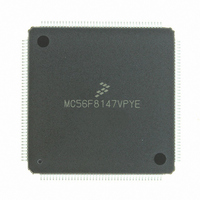MC56F8147VPYE Freescale Semiconductor, MC56F8147VPYE Datasheet - Page 120

MC56F8147VPYE
Manufacturer Part Number
MC56F8147VPYE
Description
IC DSP 16BIT 40MHZ 160-LQFP
Manufacturer
Freescale Semiconductor
Series
56F8xxxr
Datasheet
1.MC56F8147VPYE.pdf
(172 pages)
Specifications of MC56F8147VPYE
Core Processor
56800
Core Size
16-Bit
Speed
40MHz
Connectivity
EBI/EMI, SCI, SPI
Peripherals
POR, PWM, WDT
Number Of I /o
76
Program Memory Size
128KB (64K x 16)
Program Memory Type
FLASH
Ram Size
4K x 16
Voltage - Supply (vcc/vdd)
2.25 V ~ 3.6 V
Data Converters
A/D 16x12b
Oscillator Type
External
Operating Temperature
-40°C ~ 105°C
Package / Case
160-LQFP
Data Bus Width
16 bit
Processor Series
MC56F81xx
Core
56800E
Data Ram Size
4 KB
Interface Type
SPI, SCI, CAN
Maximum Clock Frequency
40 MHz
Number Of Programmable I/os
76
Number Of Timers
2
Maximum Operating Temperature
+ 105 C
Mounting Style
SMD/SMT
Minimum Operating Temperature
- 40 C
On-chip Adc
4 x 12 bit, 4 Channel
Lead Free Status / RoHS Status
Lead free / RoHS Compliant
Eeprom Size
-
Lead Free Status / Rohs Status
Lead free / RoHS Compliant
Available stocks
Company
Part Number
Manufacturer
Quantity
Price
Company:
Part Number:
MC56F8147VPYE
Manufacturer:
FREESCAL
Quantity:
253
Company:
Part Number:
MC56F8147VPYE
Manufacturer:
Freescale Semiconductor
Quantity:
10 000
finally, followed by a 32 clock window in which the core is initialized. After completion of the described
reset sequence, application code will begin execution.
Resets may be asserted asynchronously, but are always released internally on a rising edge of the system
clock.
Part 7 Security Features
The 56F8347/56F8147 offer security features intended to prevent unauthorized users from reading the
contents of the Flash Memory (FM) array. The Flash security consists of several hardware interlocks that
block the means by which an unauthorized user could gain access to the Flash array.
However, part of the security must lie with the user’s code. An extreme example would be user’s code that
dumps the contents of the internal program, as this code would defeat the purpose of security. At the same
time, the user may also wish to put a “backdoor” in his program. As an example, the user downloads a
security key through the SCI, allowing access to a programming routine that updates parameters stored in
another section of the Flash.
7.1 Operation with Security Enabled
Once the user has programmed the Flash with his application code, the device can be secured by
programming the security bytes located in the FM configuration field, which occupies a portion of the FM
array. These non-volatile bytes will keep the part secured through reset and through power-down of the
device. Only two bytes within this field are used to enable or disable security. Refer to the Flash Memory
section in the 56F8300 Peripheral User Manual for the state of the security bytes and the resulting state
of security. When Flash security mode is enabled in accordance with the method described in the Flash
Memory module specification, the device will disable external P-space accesses (disabling EXTBOOT =
1 mode), restrict memory and disable the core EOnCE debug capabilities. Normal program execution is
otherwise unaffected.
7.2 Flash Access Blocking Mechanisms
The 56F8347/56F8147 have several operating functional and test modes. Effective Flash security must
address operating mode selection and anticipate modes in which the on-chip Flash can be compromised
and read without explicit user permission. Methods to block these are outlined in the next subsections.
7.2.1
At boot time, the SIM determines in which functional modes the device will operate. These are:
When Flash security is enabled as described in the Flash Memory module specification, the device will
boot in internal boot mode, disable all access to external P-space, and start executing code from the Boot
Flash at address 0x02_0000.
120
•
•
•
Internal Boot Mode
External Boot Mode
Secure Mode
Forced Operating Mode Selection
56F8347 Technical Data, Rev.11
Freescale Semiconductor
Preliminary











